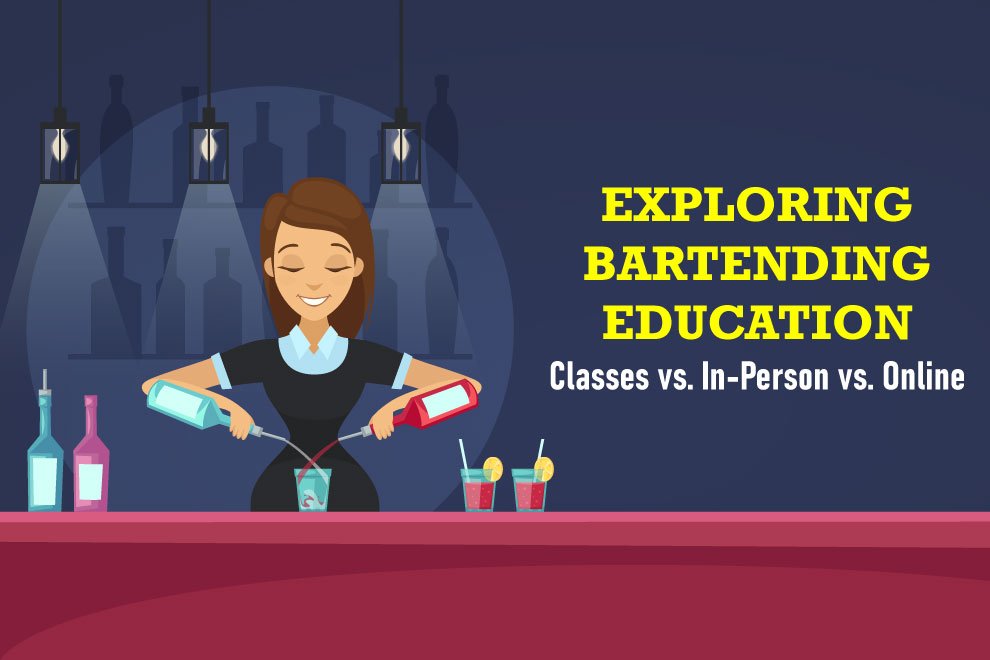Bartending is a complex craft that necessitates a combination of theoretical understanding, practical abilities, and hands-on experience. Aspiring bartenders have the option to pursue their education through traditional classes, in-person training, or online courses; each has its own set of pros and downsides.
Traditional Classes:
Traditional bartending programs are often held in a classroom setting, where students can interact with instructors and peers while obtaining hands-on instruction. The classes frequently cover a wide range of topics, such as mixology techniques, cocktail recipes, customer service skills, and basic bar management principles.
Pros:
Hands-on Experience: Traditional workshops let students to practice bartending skills using professional equipment and ingredients. Students acquire essential hands-on training that prepares them for real-world circumstances, including mixing drinks and mastering flair bartending techniques.
Immediate Feedback: In traditional classrooms, instructors can provide rapid feedback and direction to students, assisting them in correcting mistakes, refining their techniques, and troubleshooting issues as they arise.
Networking Opportunities: Traditional classes allow students to connect with other bartenders, industry professionals, and potential employers. Building contacts within the bartending community can lead in job prospects, mentorship connections, and continued support throughout one’s career.
Cons:
Limited Flexibility: Traditional classes have little flexibility because they are usually held at certain times and locations. Individuals with hectic schedules or conflicting obligations may find this lack of flexibility difficult to cope with.
Higher Cost: Traditional bartending classes or courses can be costly due to tuition fees, materials, and teacher costs. This financial investment may be exorbitant for some people, especially those on a tight budget.
Limited Accessibility: Traditional bartending classes may not be provided in all locales, limiting access for people living in distant areas or who are unable to commute to class.
In-Person Training:
In-person bartender training programs combine classroom education with practical experience in a simulated bar atmosphere. These programs are often held at dedicated bartending schools or training facilities, where students have access to professional equipment, experienced instructors, and hands-on learning opportunities.
Pros:
Realistic Environment: In-person training programs allow students to practice their bartending abilities in a real-world bar setting, replete with fully stocked bars, cocktail stations, and customer interactions. This comprehensive experience introduces students to the fast-paced world of bartending and prepares them for the demands of the job.
Personalized Attention: Instructors in in-person training programs can provide personalized guidance and support, tailoring instruction to meet the individual needs and goals of each student. Whether it’s perfecting specific techniques, honing customer service abilities, or studying for certification examinations, teachers are available to help every step of the way.
Networking Opportunities: Similar to traditional classes, in-person training programs provide opportunity for networking with peers, teachers, and industry professionals. Building connections in the bartending community can lead to job prospects, mentorship connections, and continued support throughout one’s career.
Cons:
Time Commitment: In-person training programs often require a significant time commitment, with classes spanning several weeks or months. This may be challenging for individuals with demanding schedules or other obligations, such as work or family commitments.
Higher Cost: In-person training programs, like traditional classes, can be expensive too due to tuition, materials, and equipment costs. This financial investment may be exorbitant for some people, especially those on a tight budget.
Limited Availability: In-person training programs may only be available in a few locations, limiting access for those living outside of large cities or metropolitan areas. This lack of availability may make it impossible for certain people to continue their bartending education in person.
Online Courses:
Online bartending courses are flexible and convenient, allowing students to learn at their own speed from the comfort of their own homes. These courses often include video lectures, interactive modules, downloadable tools, and online forums to provide a thorough education in bartending principles.
Pros:
Flexibility: Online courses provide scheduling flexibility, allowing students to learn at their own pace and time. Students can access course materials and complete assignments whenever it is convenient for them, whether it is in the morning, late at night, or on weekends.
Cost-Effective: Online courses are frequently less expensive than traditional classes and in-person training programs, with lower tuition fees and reduced travel, lodging, and material costs. This makes bartending education more affordable to those on a tight budget.
Accessible: Individuals from all over the world can take online classes, regardless of their location or physical constraints. Whether you live in a remote place, are unable to travel, or simply prefer the ease of learning from home, online courses provide a comprehensive and accessible choice for bartending education.
Cons:
Lack of Hands-On Experience: One of the primary disadvantages of online courses is a lack of hands-on experience and practical instruction. While theoretical knowledge can be acquired through online teaching, perfecting bartending skills requires practice, repetition, and hands-on experience. Without access to a physical bar setting and professional equipment, students may struggle to master bartending methods and applications.
Limited Instructor Interaction: Online courses may provide few opportunities for direct engagement with instructors, making it difficult for students to express questions, seek clarification, or receive tailored feedback in real time. While teachers may be accessible via email, chat, or discussion forums, a lack of face-to-face interaction can impede the learning process and reduce student engagement.
Self-Motivation Required: Online learning requires a high level of self-control, motivation, and time management abilities. Without the structure of a typical classroom setting and the responsibility of in-person instruction, students must remain organized, motivated, and focused in order to finish coursework, assignments, and achieve their learning objectives.
Finally, the best way of bartending instruction varies on personal interests, learning styles, and goals. Traditional programs provide hands-on training, direct feedback, and networking possibilities, but they may lack flexibility and accessibility. In-person training programs offer a realistic atmosphere, customized attention, and networking opportunities, but they involve a major time and cost investment. Online classes are convenient, affordable, and accessible; yet, they may lack hands-on experience, instructor interaction, and real-time feedback. Ultimately, aspiring bartenders should carefully consider their options, balance the benefits and drawbacks of each strategy, and choose the type of schooling that best fulfills their needs, interests, and ambitions in the dynamic world of bartending.












